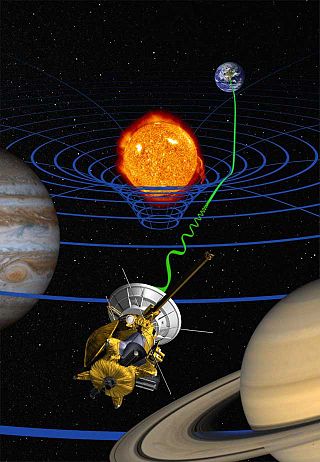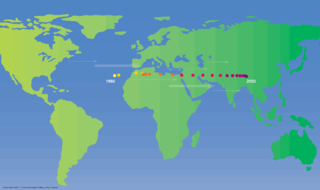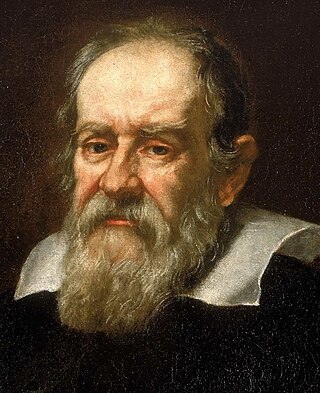Related Research Articles
In physics, the fundamental interactions or fundamental forces are the interactions that do not appear to be reducible to more basic interactions. There are four fundamental interactions known to exist:

In physics, a force is an influence that can cause an object to change its velocity, i.e., to accelerate, meaning a change in speed or direction, unless counterbalanced by other forces. The concept of force makes the everyday notion of pushing or pulling mathematically precise. Because the magnitude and direction of a force are both important, force is a vector quantity. The SI unit of force is the newton (N), and force is often represented by the symbol F.
In theories of quantum gravity, the graviton is the hypothetical quantum of gravity, an elementary particle that mediates the force of gravitational interaction. There is no complete quantum field theory of gravitons due to an outstanding mathematical problem with renormalization in general relativity. In string theory, believed by some to be a consistent theory of quantum gravity, the graviton is a massless state of a fundamental string.

In physics, gravity (from Latin gravitas 'weight') is a fundamental interaction which causes mutual attraction between all things that have mass. Gravity is, by far, the weakest of the four fundamental interactions, approximately 1038 times weaker than the strong interaction, 1036 times weaker than the electromagnetic force and 1029 times weaker than the weak interaction. As a result, it has no significant influence at the level of subatomic particles. However, gravity is the most significant interaction between objects at the macroscopic scale, and it determines the motion of planets, stars, galaxies, and even light.

In physics, a gravitational field or gravitational acceleration field is a vector field used to explain the influences that a body extends into the space around itself. A gravitational field is used to explain gravitational phenomena, such as the gravitational force field exerted on another massive body. It has dimension of acceleration (L/T2) and it is measured in units of newtons per kilogram (N/kg) or, equivalently, in meters per second squared (m/s2).
A scientific theory is an explanation of an aspect of the natural world and universe that can be repeatedly tested and corroborated in accordance with the scientific method, using accepted protocols of observation, measurement, and evaluation of results. Where possible, some theories are tested under controlled conditions in an experiment. In circumstances not amenable to experimental testing, theories are evaluated through principles of abductive reasoning. Established scientific theories have withstood rigorous scrutiny and embody scientific knowledge.
Newton's law of universal gravitation is usually stated as that every particle attracts every other particle in the universe with a force that is proportional to the product of their masses and inversely proportional to the square of the distance between their centers. The publication of the law has become known as the "first great unification", as it marked the unification of the previously described phenomena of gravity on Earth with known astronomical behaviors.
Le Sage's theory of gravitation is a kinetic theory of gravity originally proposed by Nicolas Fatio de Duillier in 1690 and later by Georges-Louis Le Sage in 1748. The theory proposed a mechanical explanation for Newton's gravitational force in terms of streams of tiny unseen particles impacting all material objects from all directions. According to this model, any two material bodies partially shield each other from the impinging corpuscles, resulting in a net imbalance in the pressure exerted by the impact of corpuscles on the bodies, tending to drive the bodies together. This mechanical explanation for gravity never gained widespread acceptance.

Anti-gravity is a hypothetical phenomenon of creating a place or object that is free from the force of gravity. It does not refer to either the lack of weight under gravity experienced in free fall or orbit, or to balancing the force of gravity with some other force, such as electromagnetism and aerodynamic lift. Anti-gravity is a recurring concept in science fiction. Examples are the gravity blocking substance "Cavorite" in H. G. Wells's The First Men in the Moon and the Spindizzy machines in James Blish's Cities in Flight.
In physics, action at a distance is the concept that an object's motion can be affected by another object without being in physical contact with it ; that is, the non-local interaction of objects that are separated in space. Coulomb's law and Newton's law of universal gravitation are based on action at a distance.

General relativity is a theory of gravitation developed by Albert Einstein between 1907 and 1915. The theory of general relativity says that the observed gravitational effect between masses results from their warping of spacetime.
In economics, Reilly's law of retail gravitation is a heuristic developed by William J. Reilly in 1931. According to Reilly's "law," customers are willing to travel longer distances to larger retail centers given the higher attraction they present to customers. In Reilly's formulation, the attractiveness of the retail center becomes the analogy for size (mass) in the physical law of gravity.

The gravity model of international trade in international economics is a model that, in its traditional form, predicts bilateral trade flows based on the economic sizes and distance between two units. Research shows that there is "overwhelming evidence that trade tends to fall with distance."

In physics, theories of gravitation postulate mechanisms of interaction governing the movements of bodies with mass. There have been numerous theories of gravitation since ancient times. The first extant sources discussing such theories are found in ancient Greek philosophy. This work was furthered through the Middle Ages by Indian, Islamic, and European scientists, before gaining great strides during the Renaissance and Scientific Revolution—culminating in the formulation of Newton's law of gravity. This was superseded by Albert Einstein's theory of relativity in the early 20th century.
The gravity model of migration is a model in urban geography derived from Newton's law of gravity, and used to predict the degree of migration interaction between two places. Newton's law states that: "Any two bodies attract one another with a force that is proportional to the product of their masses and inversely proportional to the square of the distance between them."
Mechanical explanations of gravitation are attempts to explain the action of gravity by aid of basic mechanical processes, such as pressure forces caused by pushes, without the use of any action at a distance. These theories were developed from the 16th until the 19th century in connection with the aether. However, such models are no longer regarded as viable theories within the mainstream scientific community and general relativity is now the standard model to describe gravitation without the use of actions at a distance. Modern "quantum gravity" hypotheses also attempt to describe gravity by more fundamental processes such as particle fields, but they are not based on classical mechanics.

Entropic gravity, also known as emergent gravity, is a theory in modern physics that describes gravity as an entropic force—a force with macro-scale homogeneity but which is subject to quantum-level disorder—and not a fundamental interaction. The theory, based on string theory, black hole physics, and quantum information theory, describes gravity as an emergent phenomenon that springs from the quantum entanglement of small bits of spacetime information. As such, entropic gravity is said to abide by the second law of thermodynamics under which the entropy of a physical system tends to increase over time.
Geomathematics is the application of mathematical methods to solve problems in geosciences, including geology and geophysics, and particularly geodynamics and seismology.
The radiation law is way of modeling human mobility and it gives better empirical predictions than the gravity model of migration which is widely used in this subject.
Negative energy is a concept used in physics to explain the nature of certain fields, including the gravitational field and various quantum field effects.
References
- ↑ Crymble, Adam; Dennett, Adam; Hitchcock, Tim (2017-07-27). "Modelling regional imbalances in English plebeian migration to late eighteenth-century London" (PDF). Economic History Review. 71 (3): 747–771. doi:10.1111/ehr.12569. hdl: 2299/20290 .